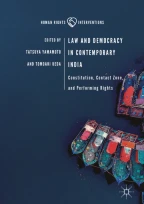
Ishizaka clarifies the role that the Right to Information (RTI) movement played in the institutionalisation process of the citizens’ right to know in India. The chapter reveals that the RTI movement in India started as part of the peasant empowerment movement and that under the latter movement, the institutionalisation process of the right to know continues till today. Ishizaka also shows that an activist organisation supporting the peasant empowerment movement has been incorporated into the institution as an indispensable agent that mediates the gap between the right to know and the right to live in contemporary India. The inner logic of how the two notions (the right to know and the right to live) are connected has not been sufficiently clear in the previous literature. This chapter clarifies that it is the activist organisation that mediates the people’s actual basic livelihood and the right to information.
This is a preview of subscription content, log in via an institution to check access.
eBook EUR 106.99 Price includes VAT (France)
Hardcover Book EUR 137.14 Price includes VAT (France)
Tax calculation will be finalised at checkout
Purchases are for personal use only

The right to know is called Jane ka adhikar in Hindi, which literally means the ‘right (adhikar)’ to ‘know (janna).’ The right to information is called Suchna ka adhikar in Hindi, which literally means ‘the right (adhikar)’ to ‘ask (suchna).’ Both terms are used nearly synonymously.
Although a movement seeking the right to know as part of the freedom of expression guaranteed by the Constitution of India also existed, the enactment of the RTI Act was mainly the outcome of the movement in which the right to know was regarded as the right to live (Naib 2013: 32–41).
There are approximately eight blocks in each district and approximately 30 panchayats in each block. In each block level, there are BDOs, and in each BDO, Junior Engineers, as Programme Officers, are responsible for conducting several programmes. There are Employment Officers in each panchayat level, and, on each worksite, there are leaders (met) of the labourers. (Interview with Mr. Shankar Singh on August 18, 2015, in Devdungri, Rajasthan.)
According to Shankar Singh, the peasants in the region depended on relief work even during a year of good monsoon of three months. Even among large-scale farmers, most of a farm’s yield was used for the farmer’s own consumption and not for sale. A famine takes place every four years. Approximately 80% of the villagers worked as migrant workers. At least one person in each household engaged in migrant work in areas such as the restaurant industry and other hospitality industries, the wrecking industry, and the construction industry. Sometimes all family members go out to work, but in many cases women, children, and elderly people remain at home. (Interview with Mr. Shankar Singh on August 17, 2015, at Devdungri, Rajasthan.)
Interview with Mr. Lal Singh on August 19, 2015, in Bhim, Rajasthan. Interview with Mr. Shankar Singh on August 17, 2015, in Devdungri, Rajasthan. Interview with Mr. Shankar Singh on August 18, 2015, in Devdungri, Rajasthan.